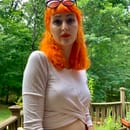My Fall/Winter Reading List
Being an English major makes reading for pleasure difficult, even though I find myself reading all the time. While I do enjoy the content I read in my four English classes, being assigned books is never quite as liberating as reading for yourself. This fall and winter break, I’m planning on checking a few novels off of my Book Bucket List.
20,000 Leagues Under the Sea by Jules Verne
I have been meaning to delve into the world of Jules Verne for a long time. He has created so many stories in strange and unusual places: under the sea, up in the air, in the center of the earth. His works are widely referenced and well-known for holding pages and pages of adventure. Lately, I’ve been inspired to expose myself to more classics, and Verne seemed by far the most exciting. My copy is especially endearing to me, as I picked it up at Wonder Books; a shop where the books come off the shelf to form a maze around the store. You need a map to navigate yourself! The book that I picked up is a little worn, but that just means it’s been loved before, and the cover art is absolutely gorgeous.
Published in 1870, this novel has been loved for a long time and heralded as a model example of science fiction writing. In it, the ostentatious Captain Nemo of the submarine Nautilis, takes on board the curious Pierre Aronnax. Arronax is currently scouring the seas to prove to the world that a horned creature (the narwhal) exists. Of course, after boarding the Nautilis, Aronnax finds the captain a little too eccentric, the crew a little too weird, and the ocean a far more dangerous place than he ever imagined. Verne himself was incredibly inspired by travel and invention, and though I am only a third of the way through the book, I can attest that these fascinations are widely and vividly described.
The Humans by Matt Haig
My best friend has told me of this book several times, and finally ended up sending me a copy for my birthday this year. I intend to give her a full report of my impression shortly after reading. Furthermore, this book seems to have quite a reputation for itself, as everyone I’ve brought it up to has ecstatically encouraged me to give it a read. Apparently, I’m in for many pages of sarcasm and aliens. To be honest, I’m not looking for any more than that in a book, anyway.
The Humans has been nominated for both the Edgar Award for Best Novel and the Goodreads Choice Awards Best Science Fiction. Author Matt Haig published the novel in 2013, and claims “this is the most I am most proud of.” The book is said to be part comedy, part science fiction, and part just plain weird. It is written from the perspective of an alien figuring out what it means to be human. It is supposed to offer human readers the chance to observe our own species as an outsider; to consider ourselves through another lens.
Prince Caspian by C. S. Lewis
Over the summer, I read the first three books in the Chronicles of Narnia series. This collection was one that I never really got into as a kid. I only watched the first film, and never tried to read any of the books. However, now that I’m older and have seen the series recognized as a great classic, I want to conquer the whole thing. I will admit, so far the books have been hit-or-miss for me. The worlds are not fully developed and, I dare say, the children aren’t that likeable. However, I am a sucker for magic and animals, and it is an admittedly charming read, so I’m vowing to stick with Lewis until the end.
Prince Caspian is the fourth book chronologically in the series, although it was technically the second published. It came out in 1951, although Lewis had completed it in 1949. Published as a children’s series, it still has a lot to offer in the world of fantasy, and literature in general, for adult readers. While there are prevalent Christian images, the series also calls on mythology and folklore to help tell its stories. They are a classic example of good versus evil presented in a world abundant with rich imagery of both its land and inhabitants. Religion played a great role in Lewis’ life and influenced his writing a great deal, but he was also a professor of literature and a man of great education. His books shouldn’t be seen through only the eyes of religion, though denying them this lens completely would discredit his work and intentions.
How to Start a Fire by Lisa Lutz
They say to never judge a book by its cover, but if the cover art is really compelling, I sometimes give in to the trope. In fact, this isn’t the first time I’ve bought a book solely for the cover art (e.g. Ned Vizzini’s It’s Kind of a Funny Story), and the last time it happened I fell in love. I only have a vague idea of what I’m getting myself into here, and over the past few years I have begun to stray from young adult literature. However, it is more than likely that I will find a book about a group of college women at least somewhat relatable, so I’m going to give it a go.
How to Start a Fire is a novel about female friendship, becoming an adult, and navigating college life. Though the characters undergo strange adventures and situations, the real story is, apparently, in their relationships with one another. Published in 2015 by Lisa Lutz, this novel is just one of ten novels she has written. Lutz has won the title of New York Times bestselling author, and began her career writing screenplays. It’s safe to say she has made quite a name for herself as a novelist, with this book in particular being described by author Megan Abbott as “whip smart… deeply funny… and profoundly moving.”
Life of Pi by Yann Martel
This isn’t a book I’ve been meaning to read, but rather one I simply happened upon. My friend and I were exploring Baltimore and came across a used book store. In it were stacks piled high with books on every genre, tumbling over onto tables and piles in crates on the floor. The shop was actually two buildings separated by a small courtyard with paintings of mermaids and knights cast onto the brick, with chairs sitting all around for eager readers. In short, my own personal paradise. My friend went ahead to the second building to check out the poetry and take some photographs with her camera, but I made a home for myself in the fiction section, scouring all of the shelves until a little orange book with a tiger on it caught my eye on the bottom shelf. I pulled it off the shelf and carried it around with me for the rest of our time around the shop, and eventually I decided to take it home. I’m not sure of what kind of adventure I’m in for, but I know it will have something to do with tigers. And math?
Published in 2001 by Yann Martel, Life of Pi tells the story of an Indian boy named Pi. Throughout the novel, he evokes themes of youthfulness, imagination, and spirituality. Eventually, he is thrown into the very extreme situation of having to share a boat with a tiger. This book has won the Booker prize, and has been made into a BAFTA and Academy Award winning film. Clearly, this is a story worth reading (or hearing, if audio books are your thing). Life of Pi has won itself awards, but also made a name for itself to its readers as an important piece of literature.


